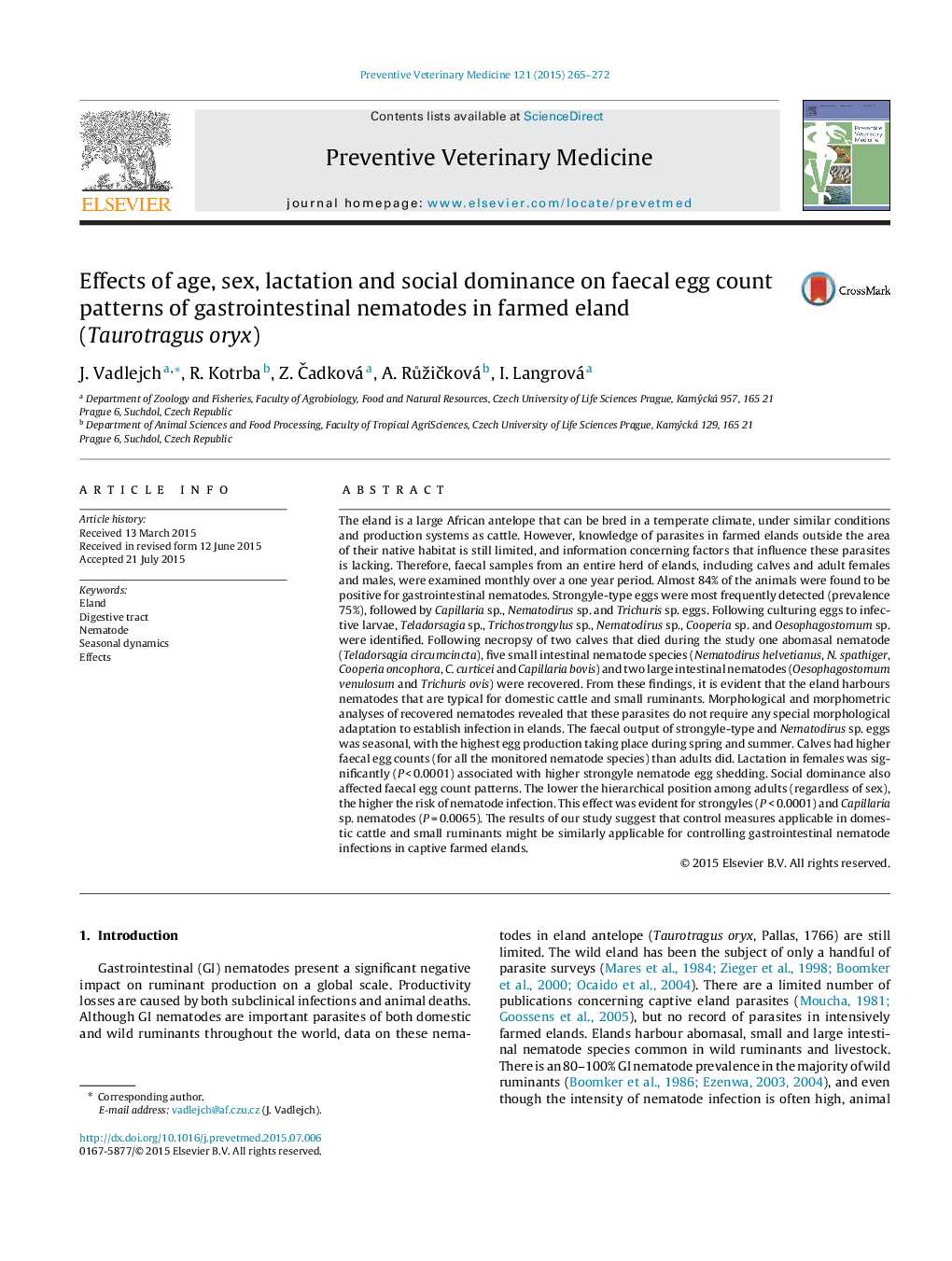| کد مقاله | کد نشریه | سال انتشار | مقاله انگلیسی | نسخه تمام متن |
|---|---|---|---|---|
| 5793209 | 1554167 | 2015 | 8 صفحه PDF | دانلود رایگان |
عنوان انگلیسی مقاله ISI
Effects of age, sex, lactation and social dominance on faecal egg count patterns of gastrointestinal nematodes in farmed eland (Taurotragus oryx)
دانلود مقاله + سفارش ترجمه
دانلود مقاله ISI انگلیسی
رایگان برای ایرانیان
کلمات کلیدی
موضوعات مرتبط
علوم زیستی و بیوفناوری
علوم کشاورزی و بیولوژیک
علوم دامی و جانورشناسی
پیش نمایش صفحه اول مقاله

چکیده انگلیسی
The eland is a large African antelope that can be bred in a temperate climate, under similar conditions and production systems as cattle. However, knowledge of parasites in farmed elands outside the area of their native habitat is still limited, and information concerning factors that influence these parasites is lacking. Therefore, faecal samples from an entire herd of elands, including calves and adult females and males, were examined monthly over a one year period. Almost 84% of the animals were found to be positive for gastrointestinal nematodes. Strongyle-type eggs were most frequently detected (prevalence 75%), followed by Capillaria sp., Nematodirus sp. and Trichuris sp. eggs. Following culturing eggs to infective larvae, Teladorsagia sp., Trichostrongylus sp., Nematodirus sp., Cooperia sp. and Oesophagostomum sp. were identified. Following necropsy of two calves that died during the study one abomasal nematode (Teladorsagia circumcincta), five small intestinal nematode species (Nematodirus helvetianus, N. spathiger, Cooperia oncophora, C. curticei and Capillaria bovis) and two large intestinal nematodes (Oesophagostomum venulosum and Trichuris ovis) were recovered. From these findings, it is evident that the eland harbours nematodes that are typical for domestic cattle and small ruminants. Morphological and morphometric analyses of recovered nematodes revealed that these parasites do not require any special morphological adaptation to establish infection in elands. The faecal output of strongyle-type and Nematodirus sp. eggs was seasonal, with the highest egg production taking place during spring and summer. Calves had higher faecal egg counts (for all the monitored nematode species) than adults did. Lactation in females was significantly (PÂ <Â 0.0001) associated with higher strongyle nematode egg shedding. Social dominance also affected faecal egg count patterns. The lower the hierarchical position among adults (regardless of sex), the higher the risk of nematode infection. This effect was evident for strongyles (PÂ <Â 0.0001) and Capillaria sp. nematodes (PÂ =Â 0.0065). The results of our study suggest that control measures applicable in domestic cattle and small ruminants might be similarly applicable for controlling gastrointestinal nematode infections in captive farmed elands.
ناشر
Database: Elsevier - ScienceDirect (ساینس دایرکت)
Journal: Preventive Veterinary Medicine - Volume 121, Issues 3â4, 1 October 2015, Pages 265-272
Journal: Preventive Veterinary Medicine - Volume 121, Issues 3â4, 1 October 2015, Pages 265-272
نویسندگان
J. Vadlejch, R. Kotrba, Z. Äadková, A. RůžiÄková, I. Langrová,